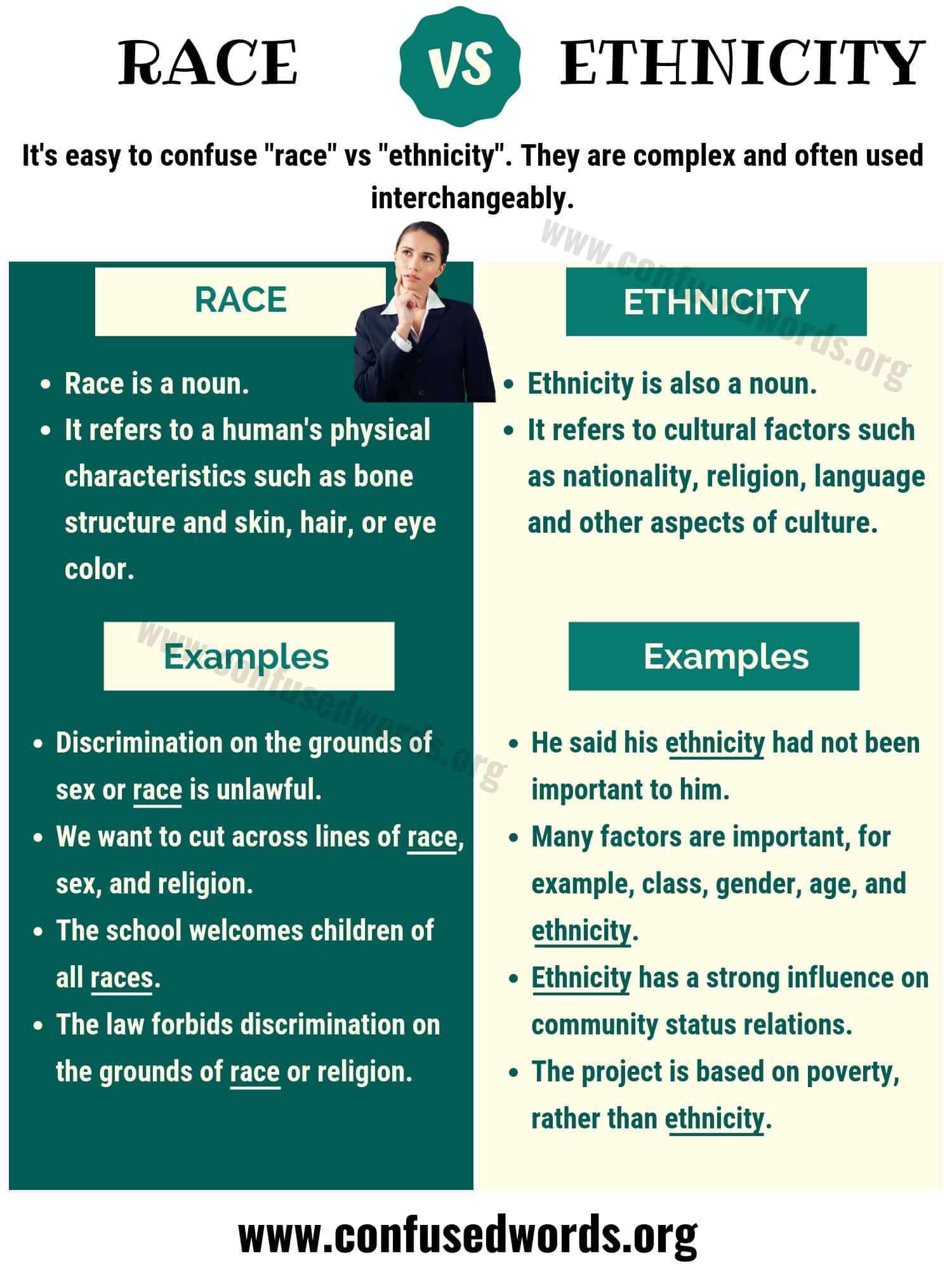Understanding The Difference In Race And Ethnicity: A Comprehensive Guide
Race and ethnicity are terms often used interchangeably, but they hold distinct meanings that shape how individuals and communities perceive identity and belonging. Understanding the difference in race and ethnicity is crucial for fostering inclusivity, promoting equality, and addressing societal challenges. While race refers to physical characteristics such as skin color, hair texture, and facial features, ethnicity is tied to cultural factors like language, traditions, and shared history. These differences influence how people interact with one another and navigate the world around them.
In today’s increasingly globalized society, conversations about race and ethnicity have become more prominent. From discussions about systemic racism to celebrating cultural diversity, these topics play a significant role in shaping policies, education, and social interactions. Recognizing the nuances between race and ethnicity can help individuals and organizations create environments that respect and value diversity. It also encourages a deeper understanding of how historical and social contexts have shaped these concepts over time.
Despite their importance, many people still struggle to differentiate between race and ethnicity. This confusion can lead to misunderstandings and reinforce stereotypes. By exploring the origins, implications, and real-world applications of these terms, we can build a more informed and empathetic society. In this article, we will delve into the difference in race and ethnicity, providing clarity and insights to help readers navigate these complex yet vital concepts.
Read also:Discovering Anna Malygon A Rising Star In The Spotlight
Table of Contents
- What is Race?
- What is Ethnicity?
- How Do Race and Ethnicity Differ?
- Why Does the Difference in Race and Ethnicity Matter?
- How Does Race Impact Society?
- How Does Ethnicity Shape Identity?
- What Are the Challenges in Defining Race and Ethnicity?
- How Can We Promote Understanding and Inclusivity?
What is Race?
Race is a social construct that categorizes people based on physical characteristics such as skin color, facial features, and hair texture. While these traits are often visible, the concept of race is not rooted in biological differences but rather in historical and social contexts. The idea of race emerged during periods of colonization and slavery, where it was used to justify hierarchies and inequalities. Over time, these classifications have evolved, but their impact on society remains significant.
One key aspect of race is that it is often perceived as fixed and immutable. For example, someone may be classified as "Black" or "White" based on their appearance, regardless of their cultural background or personal identity. This rigid categorization can lead to stereotypes and discrimination, as people are often judged or treated based on their perceived race. Despite its lack of scientific basis, race continues to influence areas such as employment, education, and healthcare.
It is important to note that race is not a universal concept. Different societies may define race in unique ways, depending on their historical and cultural contexts. For instance, in some countries, race may be closely tied to nationality or religion, while in others, it may be more fluid and subjective. Understanding these variations can help us recognize the complexity of race and its role in shaping individual and collective identities.
What is Ethnicity?
Ethnicity, on the other hand, is rooted in cultural identity and shared experiences. It encompasses factors such as language, religion, traditions, and ancestry. Unlike race, ethnicity is often more fluid and self-identified, allowing individuals to express their cultural heritage in diverse ways. For example, someone may identify as "Latino" based on their Spanish-speaking background, even if their physical appearance does not align with traditional racial categories.
Ethnicity plays a significant role in shaping how people connect with their communities and maintain a sense of belonging. It is often passed down through generations, with families preserving cultural practices and values. However, ethnicity can also evolve over time as individuals adapt to new environments or adopt elements from other cultures. This adaptability makes ethnicity a dynamic and personal aspect of identity.
While ethnicity is often celebrated as a source of pride, it can also be a point of tension in multicultural societies. Conflicts may arise when cultural differences are misunderstood or when certain ethnic groups face discrimination. By fostering awareness and appreciation for diverse ethnic identities, we can create spaces where everyone feels valued and respected.
Read also:Kirstentoosweet Ed S The Ultimate Guide To Her Influence And Legacy
How Do Race and Ethnicity Differ?
Understanding the difference in race and ethnicity requires examining their distinct characteristics and implications. While race focuses on physical attributes and is often externally assigned, ethnicity is tied to cultural factors and is typically self-identified. This fundamental distinction highlights how these concepts influence identity in different ways.
One way to illustrate this difference is through examples. For instance, a person of African descent may identify as "Black" in terms of race but also as "Nigerian" in terms of ethnicity. Similarly, someone with East Asian ancestry may be categorized as "Asian" racially but identify as "Korean" or "Chinese" ethnically. These overlapping identities demonstrate how race and ethnicity intersect but remain separate dimensions of who we are.
Another key difference lies in how these concepts are perceived and experienced. Race is often associated with systemic issues such as racism and inequality, while ethnicity is more closely linked to cultural expression and community. Recognizing these nuances can help us address challenges related to both race and ethnicity in meaningful ways.
Why Does the Difference in Race and Ethnicity Matter?
The distinction between race and ethnicity is not just an academic exercise; it has real-world implications for individuals and societies. By understanding these differences, we can better address issues of discrimination, promote inclusivity, and celebrate diversity. Misunderstanding or conflating these terms can lead to oversimplifications and reinforce harmful stereotypes.
For example, policies aimed at addressing racial inequality may focus on systemic barriers such as access to education or employment opportunities. On the other hand, initiatives that support ethnic diversity might emphasize cultural preservation, language education, or community engagement. Recognizing these distinctions allows us to tailor solutions that are more effective and equitable.
Moreover, acknowledging the difference in race and ethnicity can foster empathy and understanding. It encourages individuals to look beyond superficial characteristics and appreciate the rich tapestry of human experiences. By embracing these differences, we can build stronger, more cohesive communities that value every person’s unique identity.
How Does Race Impact Society?
Race has a profound impact on societal structures and individual experiences. From historical injustices to modern-day challenges, the concept of race continues to shape how people navigate the world. Understanding its influence is essential for addressing systemic issues and promoting equality.
Historical Perspectives
The origins of race as a social construct can be traced back to colonialism and slavery. During these periods, race was used to justify oppression and exploitation, with certain groups deemed superior or inferior based on physical traits. These ideologies laid the foundation for systemic racism, which persists in various forms today.
Modern Implications
In contemporary society, race continues to influence areas such as criminal justice, healthcare, and education. For example, studies have shown that racial minorities often face disparities in access to resources and opportunities. Addressing these inequities requires a deep understanding of how race intersects with other aspects of identity.
How Does Ethnicity Shape Identity?
Ethnicity plays a vital role in shaping personal and collective identities. It provides individuals with a sense of belonging and connection to their cultural heritage. By exploring the ways ethnicity influences identity, we can gain a deeper appreciation for its significance.
One way ethnicity shapes identity is through shared traditions and practices. For example, celebrating cultural festivals, cooking traditional meals, or speaking a native language can reinforce a person’s sense of self. These activities not only preserve cultural heritage but also create bonds within communities.
However, ethnicity is not static; it can evolve as individuals interact with different cultures or migrate to new environments. This adaptability allows people to embrace multiple identities while staying connected to their roots. By recognizing the fluidity of ethnicity, we can better understand its role in shaping diverse and dynamic identities.
What Are the Challenges in Defining Race and Ethnicity?
Defining race and ethnicity is not without its challenges. These concepts are complex and often influenced by historical, social, and political factors. Understanding these challenges can help us approach discussions about identity with greater sensitivity and nuance.
One challenge is the lack of universally accepted definitions. Different societies may categorize race and ethnicity in unique ways, leading to confusion and inconsistency. For example, someone classified as "White" in one country may not fit the same category in another. This variability highlights the subjective nature of these concepts.
Another challenge is the potential for oversimplification. Reducing race and ethnicity to checkboxes on a form or labels in a survey can overlook the richness and complexity of individual identities. By acknowledging these limitations, we can strive for more inclusive and accurate representations of diversity.
How Can We Promote Understanding and Inclusivity?
Promoting understanding and inclusivity requires intentional efforts to educate, engage, and empower individuals and communities. By fostering dialogue and celebrating diversity, we can create environments where everyone feels valued and respected.
Education plays a crucial role in promoting understanding. Teaching about the difference in race and ethnicity can help dispel myths and challenge stereotypes. Schools, workplaces, and community organizations can implement programs that highlight the contributions of diverse groups and encourage cross-cultural interactions.
Engagement is another key component. Creating spaces for open dialogue allows individuals to share their experiences and learn from one another. This can be achieved through workshops, cultural events, or online platforms that facilitate meaningful conversations. By fostering empathy and understanding, we can build bridges across differences and strengthen our communities.
FAQs
What is the main difference in race and ethnicity?
The main difference is that race is based on physical characteristics, while ethnicity is tied to cultural factors such as language and traditions.
Can someone belong to multiple races or ethnicities?
Yes, individuals can identify with multiple races or ethnicities, reflecting the complexity and fluidity of identity.
Why is it important to understand the difference in race and ethnicity?
Understanding these differences helps address systemic issues, promote inclusivity, and foster empathy in diverse societies.
For further reading on this topic, you can explore the U.S. Census Bureau's resources on race and ethnicity.
In conclusion, understanding the difference in race and ethnicity is essential for creating a more inclusive and equitable world. By recognizing the unique characteristics and implications of these concepts, we can celebrate diversity, challenge stereotypes, and build stronger communities. Let us continue to learn, engage, and advocate for a society that values every individual’s identity and contributions.
Unveiling The Mysteries Of Seeing 911: What It Means For You
Who's On The 10 Dollar Bill? Discover The Iconic Face Behind The Note
Understanding The Unique Traits Of A Tortoiseshell Personality

Difference Between Race And Ethnicity NBKomputer

Race vs ethnicity what is the difference between them? Live Science